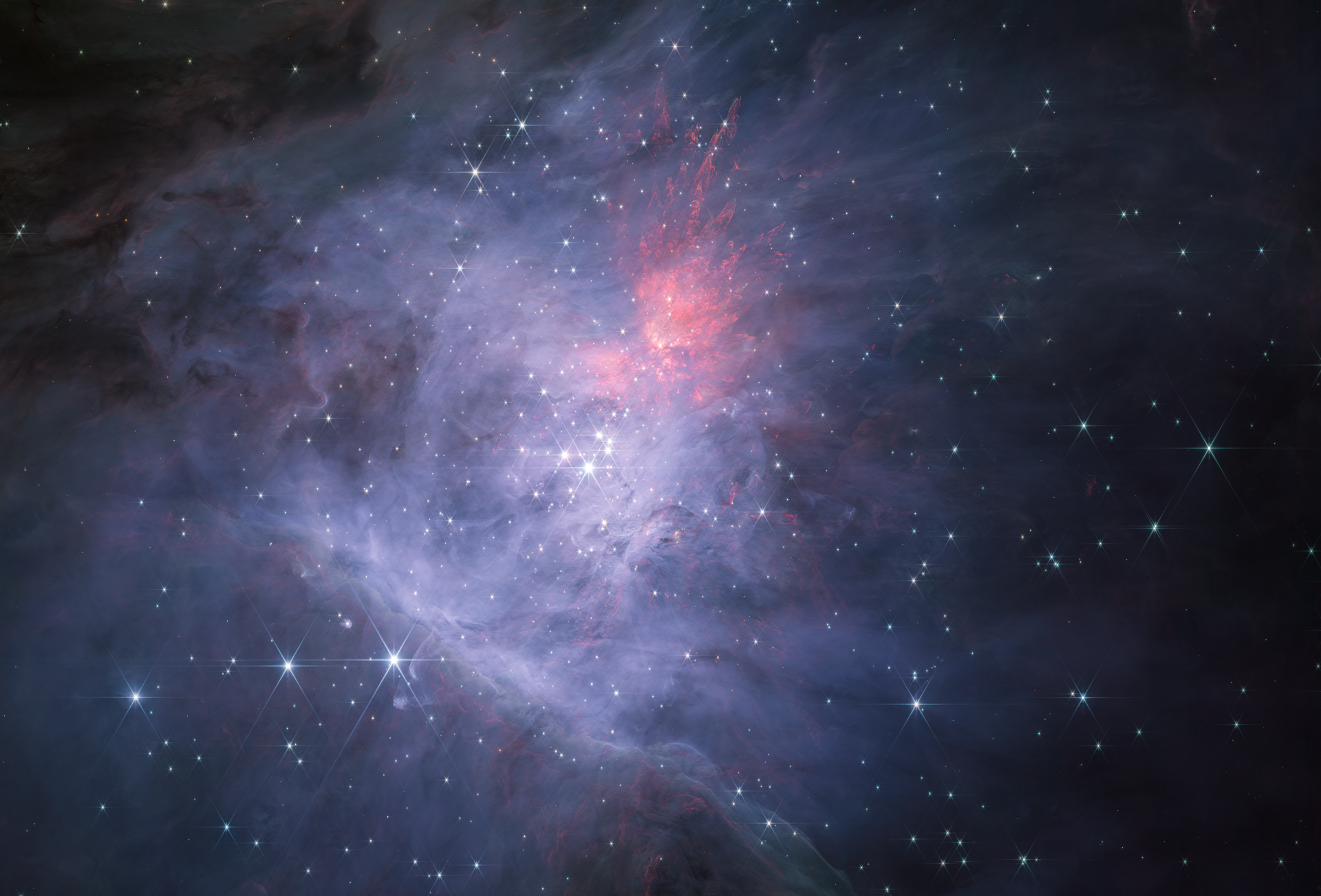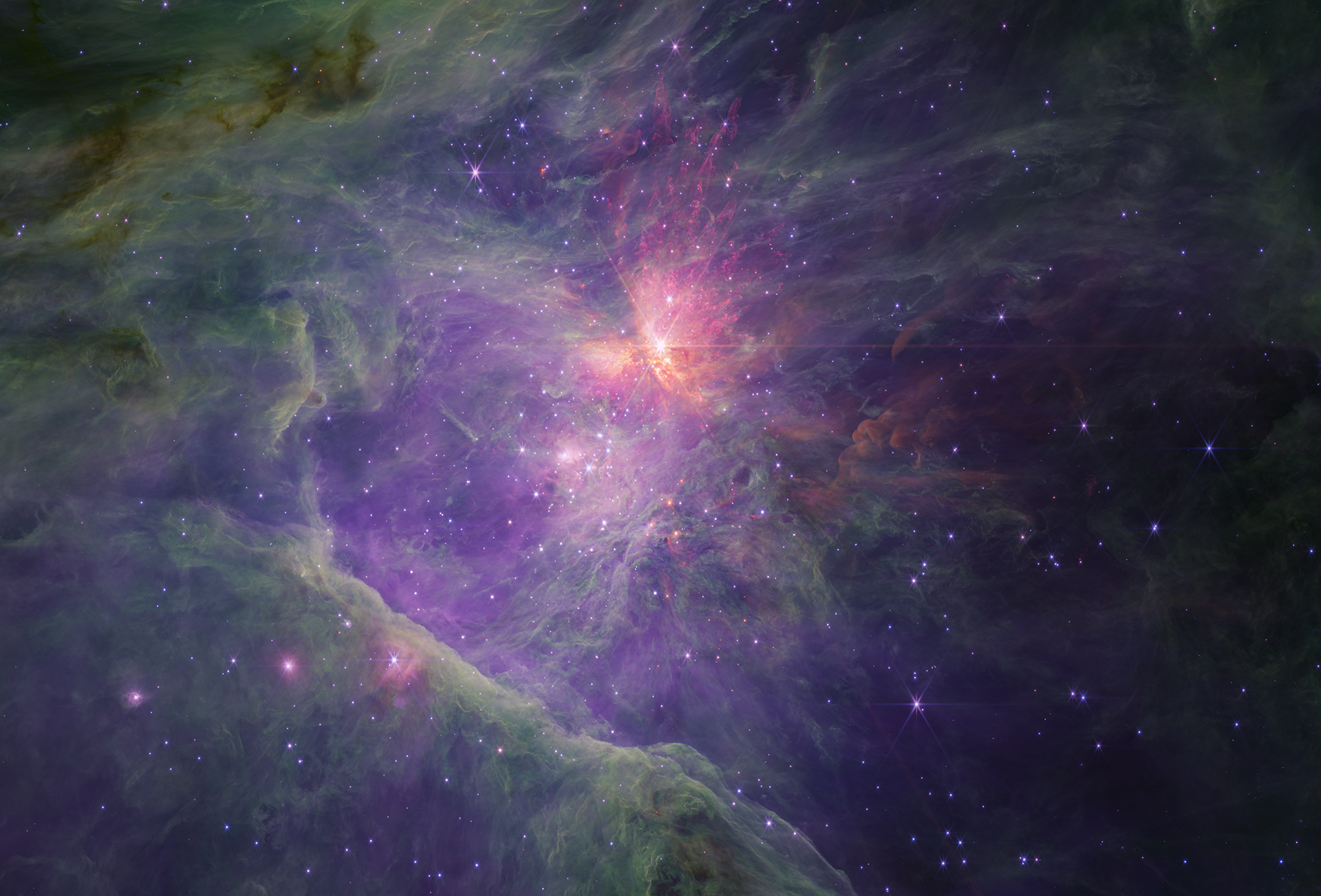James Webb Space Telescope's stunning mosaic of Orion Nebula uncovers rogue planets (photos)
The observations have uncovered 40 pairs of free-floating gas giants.

The James Webb Space Telescope has captured two stunning wide-field mosaics of the grandiose Orion Nebula, a large region of star formation that's one of the closest stellar nurseries to the solar system. It sits just 1,344 light-years away.
The huge mosaics, made of over 3,000 individual images, have also been added to the European Space Agency's ESASky app, which is an interactive all-sky map with a user-friendly interface that enables members of the public to view amazing images of the universe taken by the likes of the James Webb Space Telescope (JWST) and the Hubble Space Telescope.
The Orion Nebula is rife with budding stars located inside its billowing clouds of molecular gas. Some 2,800 young stars are known to exist inside the nebula, with many more stellar embryos cocooned within the area's dense veil of gas and dust. And the JWST’s Near Infrared Camera, known as NIRCam for short, is able to peer through much of this gas and dust — doing so has revealed proto-stellar disks, outflows from burgeoning stars, and even free-floating planets.
Related: James Webb Space Telescope could detect life on Earth from across the galaxy, new study suggests

On a winter's night, the nebula is visible to the unaided eye as a fuzzy object just below the three stars that make up the Belt of the Orion constellation. The nebula is illuminated by the Trapezium Cluster, which is a grouping of young stars so-named after the pattern of their four most prominent members. Each star in this quartet is massive, with between 15 and 30 times the mass of our Sun. Their short lives, spanning just a few millions of years rather than billions, will end in supernova explosions.
Up to a thousand fainter stars lurk in the Trapezium Cluster as well, some with evaporating circumstellar disks — these are disks of gas and dust that sprouted planets. Now, residual gas from such planet formation is being blown away by the newly awoken stars' stellar winds.
Not all of the planets born in the Trapezium have parent stars, however; the JWST has detected about 40 pairs of free-floating gas-giant planets, or Jupiter Mass Binary Objects (JuMBOs).
Get the Space.com Newsletter
Breaking space news, the latest updates on rocket launches, skywatching events and more!
Free-floating planets have been found in the Orion Nebula before, but the JuMBOs are surprising because they seem to come as couples. The question astronomers are still unable to answer is, did the JuMBOs (and other free-floating planets) form directly out of the gas of the Orion Nebula as failed stars, or were they snatched from a planetary system, perhaps by the gravity of a close-passing star that wrenched them from their orbits?
The new mosaics are split between longer and shorter wavelengths. NIRCam's short wavelength channel, which covers an infrared waveband between 0.6 and 2.3 microns, is closest to the visible red end of the spectrum and achieves the greatest angular resolution the JWST can accomplish. The short-wavelength mosaic shows all the fine details of the nebula's star-forming activity.
Meanwhile, NIRCam’s longer wavelength channel, covering 2.4 to 5.0 microns, has recorded the network of dust and organic compound filaments, known as polycyclic aromatic hydrocarbons, that abound in the Orion Nebula. PAHs are carbon-based molecules that make up a good proportion of dust found everywhere in the universe, and observations such as those of the Orion Nebula are teaching astronomers how these ubiquitous molecules form. Given how interstellar dust is recycled into the next generation of stars, PAH abundance has a role to play that the infrared vision of the JWST can reveal.
In particular, the JWST's greater spectral resolution can reveal PAHs on smaller spatial scales than ever before, helping to determine how they accumulate depending upon their molecular size, shape and electric charge.
The Orion Nebula is one of those rare objects that is accessible for inspection by everyone, from stargazers with the most basic observing kit to the most advanced space telescopes. As Orion rises this winter, what can you see in the greatest nebula in the sky?
Join our Space Forums to keep talking space on the latest missions, night sky and more! And if you have a news tip, correction or comment, let us know at: community@space.com.

Keith Cooper is a freelance science journalist and editor in the United Kingdom, and has a degree in physics and astrophysics from the University of Manchester. He's the author of "The Contact Paradox: Challenging Our Assumptions in the Search for Extraterrestrial Intelligence" (Bloomsbury Sigma, 2020) and has written articles on astronomy, space, physics and astrobiology for a multitude of magazines and websites.
-
Atlan0001 Quite a few binary JuMBOS observed and no real explanatory cause for their existence. Could it be that observation is short a trojan third entity , , , completely missing a trojan third entity either there or was there once-upon-a- time? Just maybe the two JuMBOS were a two cored single that in its speed of rotation eventually, inevitably, split apart into two singles of a binary pair like a single-celled creature that eventually expands in mass and energy enough to acquire the mass and energy to fission, or otherwise to divide, into two or more single-celled creatures . . . or universes (keeping to a constant of discreet quanta (a constant of conservation of mass and energy) out of a built-in buildup from wherever, whatever, and/or whenever)?Reply -
rod Space.com reported. "Not all of the planets born in the Trapezium have parent stars, however; the JWST has detected about 40 pairs of free-floating gas-giant planets, or Jupiter Mass Binary Objects (JuMBOs)."Reply
Rogue planets are reporting from time to time. The Trapezium is a lovely, bright area of high mass stars in my 10-inch Newtonian. Orion Nebula can be spectacular to see in my 10-inch, even in my 90-mm refractor telescope. Seeing rogue or free-floating planets in the nebula, perhaps beyond my telescopes ability presently :) -
Rorisang ReplyAtlan0001 said:Quite a few binary JuMBOS observed and no real explanatory cause for their existence. Could it be that observation is short a trojan third entity , , , completely missing a trojan third entity either there or was there once-upon-a- time? Just maybe the two JuMBOS were a two cored single that in its speed of rotation eventually, inevitably, split apart into two singles of a binary pair like a single-celled creature that eventually expands in mass and energy enough to acquire the mass and energy to fission, or otherwise to divide, into two or more single-celled creatures . . . or universes (keeping to a constant of discreet quanta (a constant of conservation of mass and energy) out of a built-in buildup from wherever, whatever, and/or whenever)?
Jumbos are caused by the Formation from a Common Gas Cloud: Binary Jupiter mass objects, such as binary gas giant planets or brown dwarfs, could form from the same gas cloud in a similar way that binary stars form. Gravity causes regions of a gas cloud to collapse, leading to the formation of multiple objects in close proximity.
Capture: One Jupiter mass object may have captured another through gravitational interactions, leading to the formation of a binary system. This can happen when two objects pass close to each other, and one gets gravitationally bound to the other.
Disk Fragmentation: In protoplanetary disks around young stars, material can clump together and form objects. Some of these clumps may become Jupiter mass objects and could potentially form binary systems within the disk.
Evolutionary Processes: Binary systems can also form through the evolution of single objects. For example, a single Jupiter mass object might undergo a process where it fragments or splits into two objects. That's how I think they were formed









